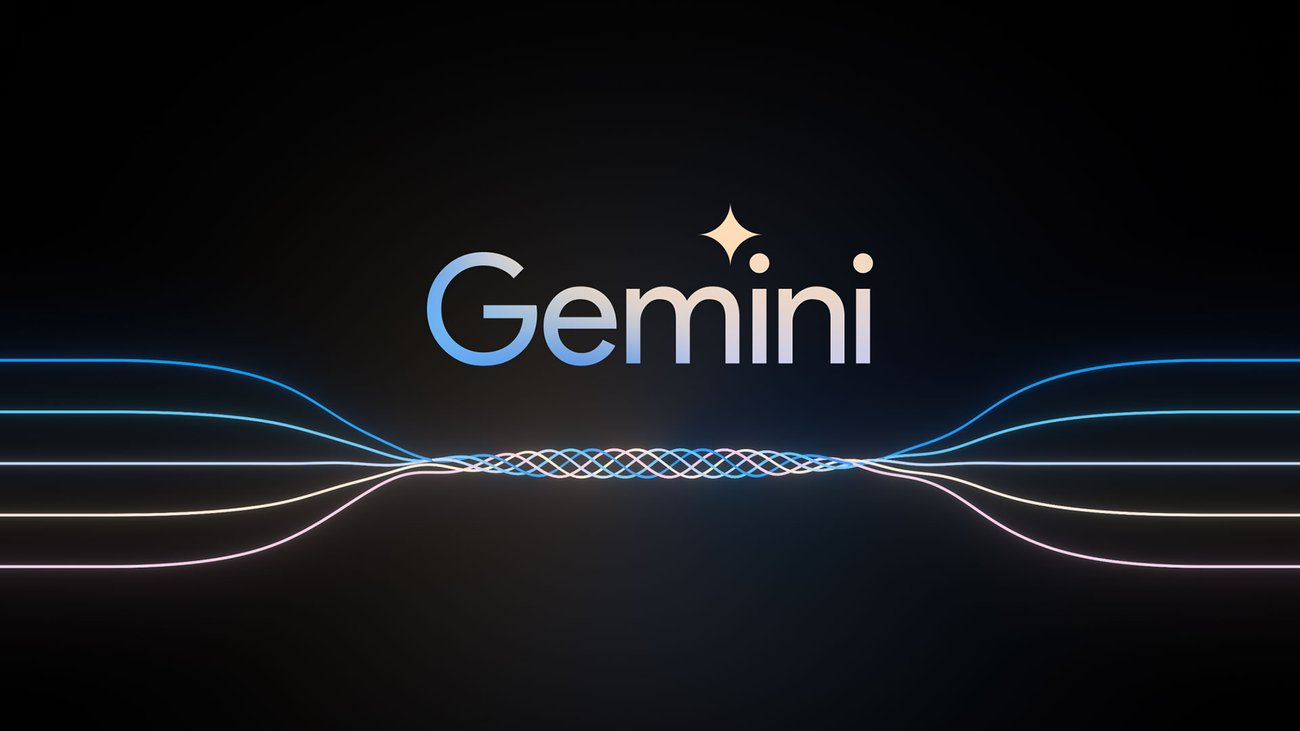
Gemini by Google is one of the leading platforms for generative Artificial Intelligence. Since it was created by Google, it’s part of our online life. It is literally everywhere. You open google.com, or Docs, or Sheets or Slides, or Gmail; everywhere, you’d see a blinking sign asking you to let Gemini help you. It is indeed one of the smartest AI tools I have used, and its functionality is just immense. In this blog, we will focus on how to get the best response to your queries with the help of a Gemini cheat sheet for prompts.
What is a prompt
In the context of AI, a prompt is the information you give to the tool so that it can, to the best of its capacity, give you the closest answer you are looking for or complete the assigned task in the best possible way.
To better understand prompt, you have to understand two jargons: Generative AI and large language models (LLMs). Knowing this means you can crack any AI terminology cheat sheet.
Generative AI, as the name has it, generates text, video, audio and other kinds of responses based on the given guidelines. Not all generative AI tools are LLMs, but all LLMs are a type of generative AI. LLMs are a specific category of generative AI models that focus on text-based data.
LLMs are trained on massive amounts of text data, allowing them to understand human language. So, when you are writing a prompt, you are giving instructions to an LLM to come up with a response that you want – be it writing a response, translating it, summarizing it, etc.
Prompts in Gemini
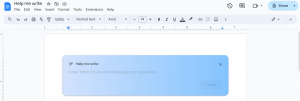
Google has integrated Gemini into Gmail, Docs, Sheets, and Slides. This helps you enter separate prompts in each of these software to get your work done. For example, Gemini in Google Docs and Gmail can help you write letters, essays and emails. In Sheets, you can give a prompt to clean the data or organize it. In Slides, it can create presentations based on your input.
The quality of response you get from generative AI tools depends upon how well you have given the instructions. Writing a good prompt is a skill, which if you acquire, would work like an AI cheat sheet helping you get the tasks done as you like them.
For a quality response, every Gemini prompt should have four features:
- Persona
- Task
- Context
- Format
Consider them like subject, helping verb and object in a sentence. Combine all three of them, and you’ll get an expression which exactly depicts the meaning you want to convey. A prompt is also like that. Let’s understand this with an example:

The first part is the persona, where you’re telling the AI model about the role they should acquire to think about your query and answer it. The second is the task which you want to accomplish. The context provides more details about the task for a better understanding of the AI. The final part is telling about the format you’d like the AI model to reply to.
To simply understand it, think of it this way: Persona is Who, Task is What, Context is When and Where, and Format is How.
The ultimate Gemini cheat sheet for prompts
AI prompt cheat sheets have a few similarities, like clear instructions, format description and conversational tones, etc. But for Gemini, Google itself has given some characteristics of an ideal prompt.
In its latest Prompting Guide 101, Google said “the most successful prompts” for Gemini have, on average, 21 words. But most people don’t know this. They write short prompts, usually less than nine words.
Understand this as short-tail and long-tail keywords in Search Engine Optimization. While generic search terms like ‘brown leather boots’ will give you mixed results from the manufacturing of brown leather boots, their different types to online stores which sell them. But if you use a more descriptive term like ‘buy brown leather boots online in San Francisco’, you’ll only get a list of shops or e-commerce stores that sell brown leather boots in San Francisco.
Give clear and specific instructions
The result generated by AI is completely dependent upon the instructions you provide. Any detailed set of instructions includes all four factors: person, task, context, and format. The more details you provide, the more elaborate and perfect response you will get.
While giving the instructions, use natural language and write in full sentences, as if you are speaking to another person. Always express your complete thoughts in full sentences.
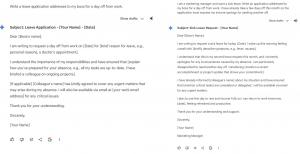
Be specific about the task
Gemini can do a whole lot of tasks for you. It can do research, improve your writing, organize data and summarize text. So, in your prompt, you should clearly convey the nature of the task. The task could be as simple as paraphrasing a passage or identifying trends in a complex data set. To get the most appropriate response, provide as much context as possible.
Specify constraints
Every task needs a separate kind of response, and each response has a different nature. A summary could be only one paragraph, but an outline of an article has to have an introduction, a body, key highlights in bullet points and a conclusion. By providing constraints about the response, you are telling Gemini how you want your response to look.
These constraints can be the number of paragraphs or headings, the length of response, the type of language, etc.
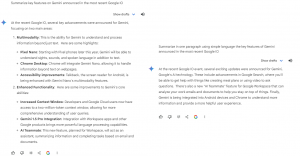
If you are not satisfied with your response, you can click on the modification symbol below the response to amend it.
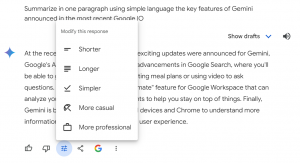
Giving constraints also means adding input or output prefixes. Input prefix explains your prompt, for example, you can give the command in two languages and give them the prefix [Language 1] and [Language 2]. For the output prefix, you can specify how you want your answer to be. For example, in a math problem, you can tell Gemini that you want your answer to be in a fraction or up to two decimal places.
Include examples
Any generative or gen AI cheat sheet you see on the internet will tell you to do one thing: give examples.
Telling Gemini how you want your response to look is great. But what is even better? Give it an example of an answer to tell how it should respond to your query. Gemini will identify the format of the example and replicate it in its answer.
Examples in Gemini are what separates zero-shot prompts from few-shot prompts.
Zero-shot prompts are the most basic ones. The users provide general instructions describing the task without any specific examples. In few-shot prompts, users give examples to guide the AI towards their desired outcome. This is like showing someone how to do something before asking them to do it themselves. Few-shot prompts help the LLM produce a much better response. See the examples below. The image on the left is a zero-shot prompt, and the one on the right is a few-shot prompt.

In the left prompt, I only defined the task and gave the context that the poem’s subject is daffodils. But, in the prompt on the right, I gave an example of William Wordsworth’s poem on daffodils to tell Gemini what I wanted the response to look like. See the difference in response from both prompts:
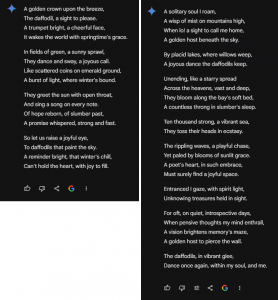
Have a conversation with Gemini
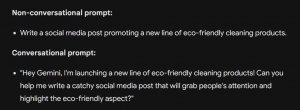
It’s very difficult to get your first response exactly the way you like. Working with AI is also like a collaboration, where several rounds of corrections, brainstorming and revisions will land you on the perfect output. With Gemini, this is done by making your prompts conversational.
To fine-tune the responses, use follow-up prompts so that Gemini better understands your query and provides you with the desired outcome. This context helps Gemini understand the nuance of your request and respond in a way that’s more relevant and helpful. You can ask clarifying questions, provide additional information, or adjust your request based on Gemini’s initial response.
Break it up

It is always better to break up your prompt into a set of instructions instead of feeding all the information in one go. For example, telling Gemini to “Write an outline for a blog focusing on the latest fashion trends of 2024, by sourcing information from reliable magazines like Vogue and Harper Bazar and highlighting the most popular of trends with a focus on wardrobe ideas for summer” is complicated.
Instead, you could start with, “Hey, Gemini, I am writing a blog on the latest fashion trends of 2024. Provide me with an outline for the blog”.
[Response]
“Great! I like the outline; can you add some examples from magazines like Vogue and Harper Bazar?”
[Response]
“Even better! Now, please tell me some trendy wardrobe ideas for the summer season.”
[Response]
This is also called sequential chain of prompts, where the output from one prompt then becomes the input for the next prompt, creating a chain that leads to the final result. This is the best trick in every generative AI cheat sheet which always gives you a new perfect response.
If you are not satisfied with the reply, you can choose among the three draft options that Gemini provides you with. If it needs further tweaking, you can adjust it through the modification option below.
Ask for feedback
Gemini and every other AI tool is still under development. While they have tons of information already fed into their –mechanical – brain, they still rely completely on you to provide the most optimal response.
By letting Gemini know what worked well and what didn’t, you can help it generate better outputs in the future, especially for similar tasks.
For example, after giving a prompt, you can ask Gemini, “What questions do you have for me?” Now, it will tell you what added information it needs to better understand your question. By providing that, you can help Gemini come up with a better response.
Say it another way
Well, you have been as elaborate as you could be, but the response is still a bit meh and lacks that oomph you want. What you can now do, instead of asking Gemini to be better at its job, frame your question differently.
This is called the iterative process of review and refinement.
If the final result isn’t what you wanted it to be, you could look again at your prompt and see if it could be improved. These could be the possible reason why Gemini is finding it hard to come up with a better response:
Unclear prompt: Maybe your initial prompt wasn’t specific enough.
Missing information: The AI might have needed additional information to understand your intent.
Limitations of the model: Gemini and all other AI models are still being developed, and there is a possibility that they are yet not equipped to perform your desired task.
Based on your analysis, you can revise the prompt to address some of its shortcomings. This might involve:
Clarifying instructions: Make your initial prompt more specific and detailed.
Providing examples: Add examples to illustrate the desired outcome you’re aiming for.
Breaking down complex tasks: If your initial prompt was too broad, you might break it down into smaller, more manageable steps.
By iterating and refining prompts, you can guide the AI towards a more accurate and relevant output that aligns with your vision. It also allows you to exert more control over the AI’s response and ensure it meets your specific needs.
Prompts for media files
Gemini can also let you upload media files, and you can ask it to do a whole lot of tasks, like describing the image, writing captions for it, extracting information, etc.
Since Gemini is primarily a large language model, its core strength lies in working with text. So, for media files, you have to be more elaborate with your descriptions. You can start with “Describe this image” and then provide it with feedback before asking it to do further tasks.
Conclusion
While a lot of people are using generative AI tools these days, not a lot of them are using them smartly. This prompt cheat sheet for Gemini is for you if you want to get the best out of Google’s AI tool. The idea is to give prompts in a clear and meaningful way so that AI can come up with the most perfect results.
As AI models become more advanced, you will see more of AI algorithms cheat sheets, but all of them have one underlying meaning: helping AI platforms to better understand the question and give the most accurate answers.
Let us know what you think of this Gemini cheat sheet for prompts and how it helped you get the best out of Gemini.